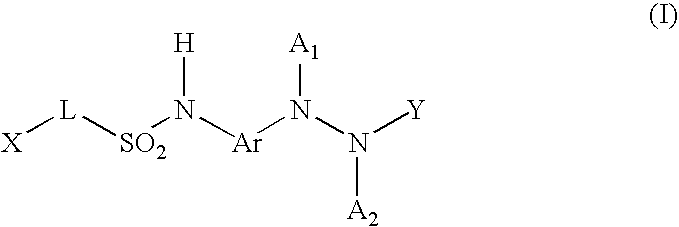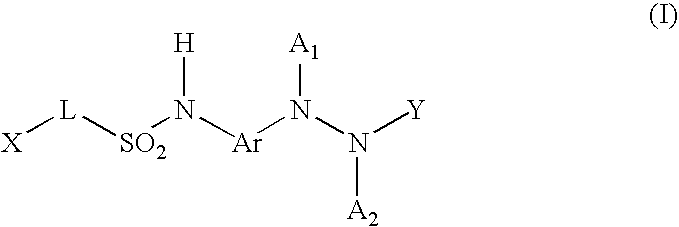Diagnostic radiographic silver halide photographic film material
a technology of radiographic and photographic film, applied in the direction of photosensitive materials, instruments, auxiliaries/base layers of photosensitive materials, etc., can solve the problems of preventing the visualisation of both thin (i.e. the skin line) and thick tissues, and increasing the incidence of breast cancer carcinoma among women
- Summary
- Abstract
- Description
- Claims
- Application Information
AI Technical Summary
Benefits of technology
Problems solved by technology
Method used
Image
Examples
example 1
[0088] 11
[0089] Acylation:
[0090] 400 g (2.68 mole) of n.-butylaniline were dissolved in 1200 ml dimethylacetamide. 298 g (2.95 mole) triethyl amine were added and the mixture was cooled to 5.degree. C. 333.7 g (2.95 mole) chloroacetyl-chloride was added over three hours. The reaction mixture was stirred at 10.degree. C. for an additional two hours. TLC analysis showed an incomplete conversion. 10 mole % triethylamine and chloroacetyl-chloride were added and the reaction was allowed to continue for an additional hour. Upon complete conversion, the reaction mixture was poured into 2500 ml of water and extracted with 1100 ml of methylene chloride. The methylene chloride was extracted three times with a 20% sodium carbonate solution. The methylene chloride was filtered over a layer silicagel and dried over magnesium sulfate. The methylene chloride was evaporated under reduced pressure. The oily residu was redissolved in 1000 ml of hexane and extracted three times with 1000 ml water. The...
example 2
[0101] 15
[0102] 2.16 g (4 mmole) of precursor hydrazide 1 were dissolved in 25 ml dimethylacetamide. 1.26 (4.8 mmole) 2-mercapto-4-phenyl-1,3,4-thiadiazole--5-thion potassium salt were added and the reaction was allowed to continue for 8 hours at room temperature. The reaction mixture was poured into 500 ml water and hydrazide 2 precipitated from the medium. Hydrazide 2 was isolated by filtration, treated twice with 800 ml of methyl-tert. butyl ether, redissolved in acetone and precipitated in methyl tert. butyl ether-isopropylacetate 1 / 1. Finally 1 g of hydrazide 2 was isolated.
example 3
[0103] 16
[0104] Intermediate 3:
[0105] 2-mercapto-thiazoline was conventionally alkylated, using one equivalent sodium methanolate in methanol and one equivalent benzyl chloride. The rearrangement of the obtained 2-benzylthio-thiazoline is described below.
[0106] 12.7 g (0.1 mole) of benzylchloride were added to 209.2 g (1 mole) of 2-benzylthio-thiazoline and the mixture was heated to 150.degree. C. for eight hours. The mixture was allowed to cool down to 70.degree. C. and 500 ml of methanol were added. The reaction mixture was allowed to cool down to room temperature and stirred for an additional hour; N-benzyl-thiazoline-thion precipitated from the medium as a white crystalline product, was isolated by filtration and washed twice with 10 ml of methanol. The crude product was recrystallized from a minimum of acetonitrile. 146 g of N-benzyl-thiazolinethion were isolated and sulfonated as described below.
[0107] 83.7 g (0.4 mole) of N-benzyl-thiazoline-thion were dissolved in...
PUM
| Property | Measurement | Unit |
|---|---|---|
| numerical diameter | aaaaa | aaaaa |
| optical density | aaaaa | aaaaa |
| thickness | aaaaa | aaaaa |
Abstract
Description
Claims
Application Information
 Login to View More
Login to View More - R&D
- Intellectual Property
- Life Sciences
- Materials
- Tech Scout
- Unparalleled Data Quality
- Higher Quality Content
- 60% Fewer Hallucinations
Browse by: Latest US Patents, China's latest patents, Technical Efficacy Thesaurus, Application Domain, Technology Topic, Popular Technical Reports.
© 2025 PatSnap. All rights reserved.Legal|Privacy policy|Modern Slavery Act Transparency Statement|Sitemap|About US| Contact US: help@patsnap.com



